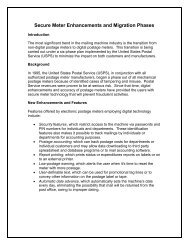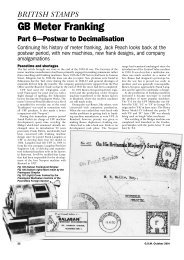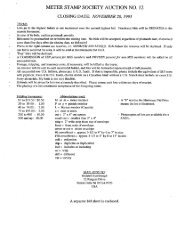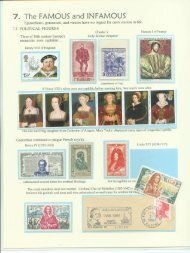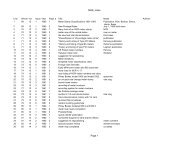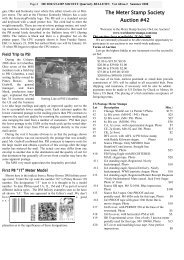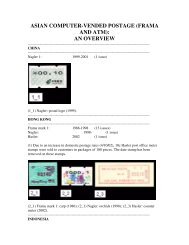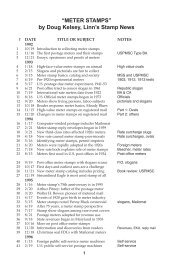The Meter Stamp Society.pdf
The Meter Stamp Society.pdf
The Meter Stamp Society.pdf
Create successful ePaper yourself
Turn your PDF publications into a flip-book with our unique Google optimized e-Paper software.
Page 4 METER STAMP SOCIETY Quarterly BULLETIN Vol. 60/no.3 Autumn 2008<br />
according to its weight and destination. After inserting a 25c<br />
coin, the cost of registration for both inland and foreign letters, a<br />
flap could be lifted and the letter inserted, taking care to place it<br />
address upwards and in the right direction following the instructions<br />
provided (Figure2). Whilst these instructions were carefully<br />
printed on the back of the receipt one assumes that a copy<br />
was also placed on the machine itself to guide the prospective<br />
user. A handle on the right of the machine was then turned, the<br />
letter dropped inside, and the receipt emerged as proof of posting.<br />
On that appeared the date, office or apparatus designation,<br />
and the registration number. <strong>The</strong> sender then filled in the details<br />
of the addressee on the receipt. <strong>The</strong> letter itself fell into a compartment<br />
and was stamped in the bottom left corner with a large<br />
letter R and the registration number as on the receipt. After the<br />
machine had been cleared a 25c stamp for the registration fee<br />
paid was added by the post office to each letter.<br />
Measures to prevent fraud elicited the high admiration of the ‘Le<br />
Journal des Philatélistes’. If a coin was inserted but no letter in<br />
order to attempt to perpetrate a fraudulent claim, no receipt was<br />
delivered, but the machine retained the money. <strong>The</strong> correct functioning<br />
of the apparatus depended on proper payment which then<br />
released the handle which set in motion all subsequent operations.<br />
A magnet picked up any spurious coins with iron content,<br />
but allowed the true 25c nickel coin to pass onward as intended.<br />
Apparently the magnet slowed down the nickel coin because any<br />
other metal went through the machine too quickly and was also<br />
rejected. Under size coins of the wrong value were also deflected<br />
from the correct route and thrown out. Finally should the<br />
machine run out of receipts a closed sign popped up and no more<br />
coins could be inserted. Letters incorrectly franked, or indeed<br />
not franked at all, would not be forwarded, though how they<br />
would be dealt with was not<br />
specified.<br />
Paul Lamar in his article<br />
carefully reviewed the information<br />
provided by Messieurs<br />
Strowski and Brunel. Strowski<br />
clearly drew on Brunel’s work<br />
and both show the same receipt<br />
with an impossible date of<br />
1900. However the text is the<br />
same as that on the one examined<br />
by Paul Lamar which<br />
would suggest a genuine receipt<br />
poorly copied or transcribed.<br />
<strong>The</strong> October receipt<br />
seen by Monsieur Lamar has<br />
the month abbreviated to OKT.<br />
Since the inventor was Hungarian<br />
and German the language<br />
used in the Austro Hungarian<br />
Empire it simply means<br />
that the date slugs were not<br />
updated for use in France. <strong>The</strong><br />
1909 article confirms that the<br />
Figure 3. Drawing of<br />
Fodor Machine.<br />
month was in German and the number 1 after the date the number<br />
allocated to the apparatus. Subsequent machines were intended<br />
to have the number of the post office itself at that point.<br />
Monsieur Lamar felt that the drawing of the machine must have<br />
been done from a sketch of the actual apparatus. Such a precise<br />
sketch could not be<br />
purely a product of<br />
an artists’ imagination,<br />
Figure 3. It first<br />
appeared in Brunel’s<br />
book and nothing of<br />
its origin is known.<br />
Three letters are<br />
now recorded and the<br />
period of use began<br />
on 29 July 1909 and<br />
continued until at<br />
least October. Nothing<br />
seems to be<br />
known about its withdrawal<br />
but it is does<br />
not seem likely that it lasted much beyond October 1909. <strong>The</strong>re are a<br />
number of unused envelopes around which appear to be a demonstration<br />
of how such letters would appear. I do not know when they were<br />
produced or what their status is, the example here has been done the<br />
wrong way round with the R etiquette at top right instead of bottom<br />
left, Figure 4.<br />
Letters Known<br />
Figure 4. Proof Cover on Antal Fodor<br />
corner card.<br />
Date Franking Destination Reg # Source<br />
3.8.1909 25+25c Belgium R190 Author<br />
16.8.1909 25+25c Switzerland R792 Sinais Auction<br />
58, June 2005<br />
2.10.1909 10+25c Amiens R375 Paul Lamar<br />
<strong>The</strong> number on the October cover does not fit with the other two.<br />
On the receipts seen there seems to be no space for a fourth digit for<br />
the registration number so it may simply have repeated on reaching<br />
999.<br />
Bibliography<br />
1. ‘Le Journal des Philatélistes’ for 1909.<br />
2. Le Patrimoine de la Poste Flohic Editions 1996 page 231 outlines<br />
the career of Julien Simyan.<br />
3. Les Feuilles Marcophiles 235 1983 article by Paul Lamar pages<br />
11-15.<br />
4. Les Estampilles Postales au XX e siècle S Strowski 1933 pages<br />
126-127.<br />
5. La Poste à Paris Georges Brunel 1920 pages 378-379.<br />
<strong>The</strong> last is a book to be used with caution; it has many fascinating<br />
snippets but gives no sources. Much has been found incorrect with<br />
subsequent research. Cross check with other sources for accuracy.<br />
Editor’s Note: <strong>The</strong> existence of another experimental registration<br />
machine came to our attention this summer from a note at<br />
www.philatelicdatabase.com. This provides the text from a British<br />
Newspaper, the Standard, which misspells the name as Fabor. We<br />
thank Stanley Luft and Peter Kelly and Martin Stempien of the<br />
France and Colonies Philatelic <strong>Society</strong>, www.fcps.org.uk, for helping<br />
us find Christopher Hitchen and his wonderful article about this<br />
interesting experimental postage registration device.<br />
(Continued Page 11)





